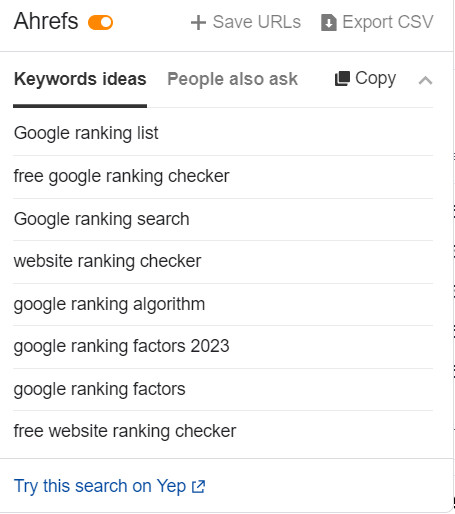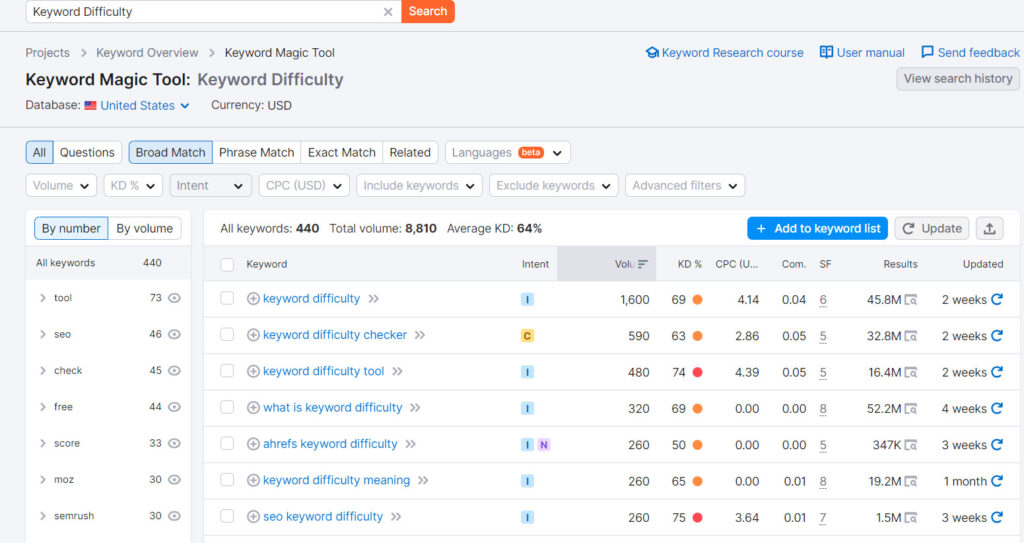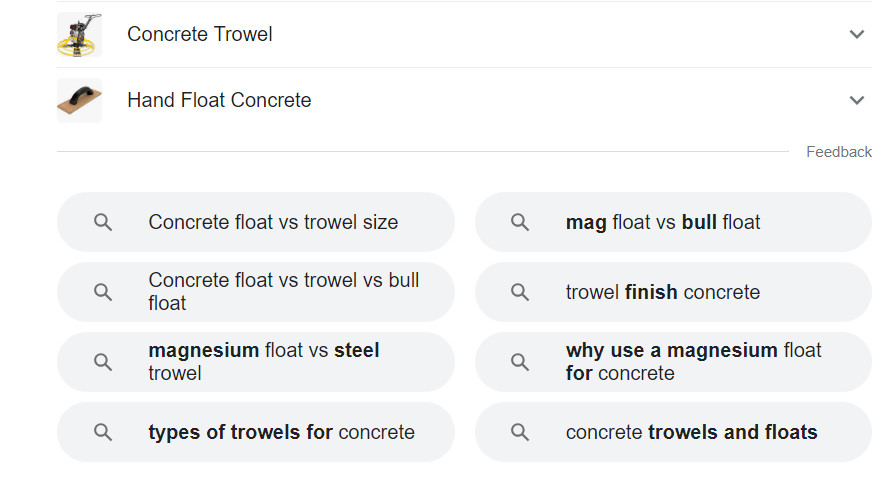The success or failure of your internet business may depend on your Google ranking.

9 Steps to Rank No. 1 on Google 2024
If you think that sounds a little dramatic, keep in mind that roughly 54% of all clicks come from the top 3 Google search results. And that 25% of clicks typically go to the top result.
A good Google ranking offers other advantages besides just more traffic, though. Your brand recognition and conversion rates will soar through the roof if you can secure the top spot for the proper keywords.
I’ll show you exactly how to achieve Google page one ranking in this step-by-step manual so that you can start enjoying these advantages.
What you will learn
- To choose a term with ranking potential and that is relevant to your business, keyword research is essential.
- When selecting realistic keywords, you should take into account four things: keyword difficulty, search intent, business potential, and search volume.
- By incorporating relevant keywords in your post and paying attention to on-page SEO (Search Engine Optimization), you may help search engines understand the intent and context of your material.
- After publishing, increase content visibility by promoting it via link-building, email, and social media.
- Make content hubs that address several facets of a subject to help you build topical authority and improve your Google rankings.
- To save time and effort, examine the material of your competitors. They have previously conducted the research to determine which subjects search engines view as pertinent.
- As you create more material, keep an eye on your keyword ranks, impressions, and pageviews.
- Every 90 days, review your posts to find any problems or new chances. If your material is out-of-date or not ranking, update it.
1. Research keywords
Putting a lot of time and attention into your keyword research is the first step to pushing your content to the front page of Google search results.
You must specifically pinpoint the keywords that members of your target market are using to seek online and for which your website has a good possibility of ranking highly.
Make a list of keywords that are pertinent to your business to begin with.
For instance, if you’re creating a website for a company that performs concrete repairs, some of your seed keywords might include foundation repair, driveway repair, and concrete repair.
Alternately, you might begin by using standard tools like a trowel, sledgehammer, groover, and concrete float.
You may quickly come up with more ideas by using the Ahref Chrome Extension. Simply enter your search into Google, and Surfer will take care of the rest:

After repeating that a few times, you’ll have a good list of pertinent keywords that relate to your specialty and are used by potential customers.
However, you won’t be able to rank for every term you choose in this phase on the first page of Google. You may need to narrow your emphasis depending on how reputable your website is.
Related :10 Ways to Improve Your Blog Traffic 2024
2. How to select relevant keywords
It can be tempting to focus only on the Google searches for those terms. However, those are also the most competitive keywords, making it more difficult to rank for them.
Instead, focus on keywords that are practical targets for your website and you’ll fare far better in the Google ranks.
Focus on these four essential components when choosing your target keywords to achieve that:
Keyword difficulty
You must ascertain the likelihood that any keyword you are considering will rank for your site. If you choose a too-competitive niche, your material will fall to the bottom of the search results.
A quick technique to determine how tough a keyword is to use is to look through the search engine results. For instance, the following is what Google’s first page for “concrete float” displays:

Over 28 million outcomes! Additionally, major merchants like Home Depot, Lowes, and Amazon dominate the top of the list. No matter how you look at it, that is a stiff competition.
The scenario is different, though, if we consider one of Surfer’s related keyword suggestions. Google’s search results for “concrete float vs trowel” are as follows:

Even though there are still about 1.4 million results, the first few pages are primarily informational posts from blogs and websites that are related to business. No e-commerce behemoth in sight!
The top 10 results also include a StackExchange question. That’s encouraging because it shows that individuals are turning to forums when they can’t find the information they need elsewhere on the internet, like blog posts.
You have a decent chance of ranking if you can use your content to fill that gap. Overall, this keyword has substantially lower competition than the basic term “concrete float.”
Search intent
Prior to attempting to produce an article targeting a specific keyword, you should have a clear idea of what users are seeking when conducting a search for that term. By examining the SERP, you can get a pretty clear picture of what Google believes the search intent is for a given keyword.
Using the “concrete float vs trowel” query as an example, we can observe that the top results emphasise explaining what these tools are and how to use them.
Google, in example, provides results that can be used to learn how to use concrete floats and trowels for DIY repair projects.
This would be a good fit because that is unquestionably pertinent to the work that our fictitious concrete repair company undertakes. But there are still additional things to take into account.
Business potential
Make sure you understand how the material will actually benefit your readers before you decide to publish an article that targets a specific term. In particular, if you can meet the reader’s search purpose while writing on subjects related to your industry, you’re certainly on to something.
It is more preferable to rank for a keyword with low search volume that is relevant to your industry than to focus on terms that are less relevant merely because they have a bigger search volume.
Search volume
Speaking about search volume, it’s crucial to choose keywords that receive a sufficient number of monthly searches to have the ability to provide quality visitors to your website.
Don’t disregard low volume long-tail keywords, though. Some extremely targeted keywords with little search traffic could have high conversion potential.
For instance, the majority of SEO tools reveal that less than 100 times per month are spent searching for “best concrete float”. But it’s likely that those who look for that phrase desire to purchase a concrete float.
Your odds of turning a few readers into customers are fairly good if you can get your review post on the first page of Google.
3. Include related keywords in your article
Google and other search engines are constantly improving their capacity to recognise the context and search intent of a user’s query. As a result, they are able to provide the greatest and most pertinent results for each search.
By inserting terms associated with your core topic in each of your postings, you may aid Google in determining where your information belongs. Because you’re leaving hints about the queries your content responds to, covering semantically relevant keywords increases your chances of ranking highly for a variety of related terms.
However, it’s not always clear which terms work best on different pages and which belong in the same article. The Google search results may appear to be extremely similar for terms like “sidewalk crack repair” and “garage floor crack repair,” yet they are very different.
Fortunately, you can find fantastic related keywords for your blog entries by using Google itself.
This is how:
- In Google, begin typing your seed term, and take note of any other keywords that appear in the Autosuggest dropdown.
- View the list of queries under “People also ask”
- Take notice of the keywords Google lists under “Additional searches” at the bottom of the results page as you scroll down.
- Make a list of additional keywords to include in your post using these three tools.
- For the new set of keywords, repeat steps 1 through 4 until you have a sufficient number of semantic phrases for your blog post or until you begin to encounter duplicates.
The final step is to choose the keywords you wish to utilise because not all of the keywords you collect through this technique will apply to the article you’re writing.
Remove any that don’t fit the purpose of your post, for instance.
Google informs us that relevant searches for “sidewalk crack repair” also include “sidewalk repair kit” and “driveway crack repair”:

We should refrain from utilizing the phrase “driveway crack repair” in our post if we are not writing about driveways.
4. Make use of on-page optimization
The best opportunity for your content to appear on Google’s front page is to pay strict attention to on-page optimisation. You may make it easier for search engines to comprehend the context and intent of your content by incorporating your keywords in four important places in each post.
The four specific places where your keywords must be used are as follows:
Page title
The page title, which also functions as the H1 tag, indicates the main theme of your post.
Your main target term should be included in the title tag, which should be between 60 and 70 characters long. Additionally, it must be a real title that people can comprehend.
Header tags (h2-h6)
Your post’s divisions and subsections should be thoughtfully structured to make it easier for the reader to follow the material flow. However, avoid using your main term in the H2-H6 header tags for these paragraphs.
Rather, concentrate on keyword variations and the associated keywords you found in step 3 above. This gives search engines more information about the purpose and overall scope of your post.
URL structure
In your post’s URL structure, mention your main keyword. This gives search engines even more clue about the topic of your post.
Additionally, you want to include the goal word in your URL while keeping it as short and straightforward as you can.
Meta data
You have 155–162 characters in the meta description to give a succinct summary of your content. It simply represents the promise you make to search engines about what you will offer users, and it also appears on search result pages alongside your page title and URL.
Improve search ranks by including one or two of your keywords in the meta description.
You may persuade potential readers to click through to your content by using the meta description. Keep it brief and to the point, but be sure to offer the searcher a taste of what they may expect to discover if they continue reading.
5. Promote your post
Only half of the work is done when a post is written and published. To ensure that the greatest number of people see your content, you must also promote it.
The three major methods for increasing traffic to your content are as follows:
Build links
You can quickly increase traffic to your blog article using email and social media, but this is only a temporary bump. Furthermore, it won’t help you get better organic search results.
You must develop links to your post from other websites if you want to see long-term growth and consistent organic traffic. Brian Dean at Backlinko claims that in actuality
“The #1 result in Google has an average of 3.8x more backlinks than positions #2-#10.”
You can create backlinks to your content in the following ways:
Write guest posts
If you do it properly, posting on other blogs can help you earn a quality backlink to your own website while also exposing your work to a new audience.
When launching a guest posting campaign to create backlinks, seek for chances on websites that meet the following requirements:
1.The website has material that is pertinent to your website.
2.The website is reliable and trustworthy.
3.You receive at least one backlink that is do follow to your content.
As an alternative to repeatedly publishing on only one or two websites, you should try to write guest posts for a number of different websites.
Broken-link building
Many websites contain broken links that lead to outdated content or content that cannot load due to technological issues.
By pointing out the issue and providing your content as a replacement for the broken links, you can assist those sites while gaining some new backlinks.
competitor research
There’s a good chance that sites connecting to your competitors’ material are also linking to your competitors. Finding out who is connecting to your rivals isn’t too difficult these days because the majority of SEO tools give you a complete backlink analysis for any domain.
Find the websites that aren’t also linking to you from the list after you have it.
Then, get in touch with them to see if you can contribute a guest post or mention a section of your website’s material that would be a useful reference (and a backlink!) for one of their pieces.
brand references
Doing a Google search for the name of your website or business is one quite simple technique to locate backlink chances. Find any websites that reference you in their content but don’t directly connect to your site by going through the results.
After that, get in touch with those other websites to express your gratitude for the mention and request that they include a link to your website.
You must put some time and effort into this because authoritative domain backlinks continue to be one of the strongest ranking signals in SEO.
To help set up and manage your link-building efforts, you can utilize a cold email solution like Postaga or Mailshake.
Email your subscribers
Although link-building is important for your post’s long-term success, you should also send an email to your list immediately away.
Your email list is likely to engage strongly with the post and may even point out errors that you overlooked, so it won’t just be eyes on the fresh content.
If you have established partnerships in place, you may also get your post in front of other people’s lists.
Make a social media post
Additionally, you ought to post your fresh content on the numerous social media channels. Social media can help you acquire some early traffic, but it won’t help you much in the long run.
Additionally, social media marketing is a great method to interact with the larger specialty community and perhaps even get some brand mentions.
6. construct content hubs
Building out content hubs will help you position your website for long-term success rather than publishing just one post on a certain subject.
With a series of connected blog entries, you can cover multiple distinct facets of a subject using content hubs. Each one can delve deeply into a certain subtopic, allowing you to gradually fill out the whole subject.
The development of topical authority, which raises the ranking of your content in search engine results, depends on this kind of comprehensive coverage.
The resource on working remotely from Zapier is an excellent example of a content hub:
They created their manual as a collection of essays, each of which focuses on a distinct facet of remote work. With this strategy, they can expand on their already substantial topical authority while thoroughly covering all the sides.
Applying this tactic, you might create a content hub with a pavement repair focus for a fictional concrete repair business. It would be best to have separate blog articles devoted to specific subtopics like:
- sidewalk crack repair
- sidewalk leveling
- sidewalk maintenance
- sidewalk repair tools
- who is responsible for sidewalk repair
Additional relevant subjects may be added to this cluster as well. Just be sure they’re all directly relevant to the central issue of “sidewalk repair” and will benefit your readers’ comprehension of the subject as a whole.
7. Examine your SERP’s opposition
An effective SEO tactic that can help your site rank higher and save you time and effort is monitoring the content of your competitors.
After all, your top-ranking rivals have already conducted the research necessary to determine the keywords and kinds of articles that are most effective in achieving high rankings. To gain insights for your own articles and keep from making the same errors they did, follow their example.
To start, you must determine who your organic rivals are. You may accomplish this by conducting a Google search for your desired keywords and noticing which websites appear at the top of the results.
You may also create that list with the aid of Surfer and other SEO tools.
Then, compare that list to the keywords your website ranks for by using your SEO tool to determine the top keywords used by your rivals.
Any term on their list but not on yours presents a chance for you to create and rank fresh content.
8. monitoring blog performance
The long-term success of your website depends on you monitoring the performance of your content over time. It’s the only way to know whether your efforts to publish and promote your articles are yielding the desired results.
The good news is that you don’t have to dedicate all of your time to monitoring the effectiveness of your blog.
In actuality, according to Databox, only 46% of businesses rely on more than three critical SEO performance indicators, while 86% of businesses track ten or fewer data.
In light of this, the following are three crucial metrics you should monitor for the information you publish:
rankings and impressions for keywords
Your target keyword should move up in the search engine results over time. Along with your ranking, your article’s impressions, or how frequently it shows in search results, should also rise.
You may get a fair picture of your post’s overall search exposure by looking at its average SERP position and impressions over time.
Page views and sessions
A high keyword position and a large number of SERP impressions are meaningless if no one clicks through to read your article.
Determine traffic trends and patterns by monitoring how your pageviews increase or decrease. In general, you want to observe a steady increase in the number of pageviews for each content.
The same is true for tracking sessions, which allows you to keep track of how frequently people visit your website. This enables you to identify the posts that are driving the most organic traffic to your site overall at the page level.
You should have significantly more pageviews than sessions. That suggests that once they are on your site, users click through to several articles.
Time on page (TOP) and click-through rate (CTR)
You can determine how well your article title and meta description match search intent by looking at the click-through rate.
Users won’t click to read your content if it appears in search results but your title and meta description don’t seem to fit what they’re looking for. Therefore, your CTR will be poor.
The time spent on the page similarly offers you a decent indication of how well your material itself is received.
Something is probably wrong if your CTR is strong but visitors only stay on your page for a short while before returning to the search results page. Most likely, your post is either difficult to read or doesn’t match the reader’s needs.
In any case, a low CTR or time on page indicates that viewers are not engaging with your material.
You’ll better serve your target audience and achieve better overall outcomes if you can identify the issue and remedy it.
9. Review every 90days
In order to spot potential prospects for growth and pinpoint any problems that might be hurting your SERP results, you must continuously evaluate your content.
Even if you rank first in Google for your intended term, it’s unlikely that you’ll stay there for very long. Ranking formulas are always changing, and the competition is becoming more intense.
The majority of posts also require periodic updating to reflect new knowledge or developing trends. Even timeless content can become stale over time as social mores and fresh findings alter our perspectives on certain issues.
As a general rule, you should check your content’s performance in the SERPs and ensure that it is current and correct every 90 days using a tool like Google Search Console.
How much does it cost to be Google’s top ranking?
The first page of Google organic results cannot be purchased; however, Google advertisements can be used to appear at the top of search results.
Instead, the time and effort you invest in creating quality content that addresses all the issues we’ve covered in this post will be your costs for achieving a #1 ranking.
Naturally, you’ll also have to pay for any tools you use, as well as any authors you hire if you’re not producing the content yourself.
When will my website start to rank in Google?
The time it takes to rank on Google might range from a few days to several weeks or even longer. Several factors affect how long it takes to rank, including the exact time.
For instance, content on new websites typically takes longer to index and rank than content on older, more reputable websites. For example, it’s not unusual for new sites to take several months to begin ranking on brand-new domains.
On the other hand, websites with a track record of publishing high-quality content can have fresh postings rank quickly.
To put some numbers to this concept, Neil Patel looked at 20,000 freshly published pages from a variety of websites a few years ago.
He discovered that, on average, for their main keywords, they peaked at position 1.81 on Google. They arrived there in an average of 3.39 months after they were published.
The good news is that by using internal linking and creating backlinks to your website, you may be able to rank more quickly. Internal links between pages on your website assist Google in recognizing the context and organization of your content.
Additionally, you may raise the authority of your website and increase your chances of appearing higher in the SERPs by constructing high-quality backlinks from reliable sources.
The most crucial thing to keep in mind is that obtaining a position on Google’s first page requires sustained effort. You may obtain solid, long-lasting results that will keep your blog expanding by continuously providing high-quality material and using a methodical approach to SEO.
Key conclusions
- The secret to appearing at the top of Google search results is thorough keyword research. You won’t succeed if you choose the wrong keywords for your niche and website. But if you focus on the appropriate keywords, you’ll position yourself for success.
- By incorporating relevant keywords into your articles and taking care of your on-page SEO, you may aid search engines in understanding the intent and context of your material. Create content hubs to strengthen your topical authority and provide all the information your users need to find the answers to their questions.
- Observe data like click-through rate, impressions, and pageviews to monitor the effectiveness of your material over time. Adjust as necessary, and keep an eye out for methods to raise the quality of your content and position on search engines.
- Keep in mind that it takes time and effort to rank on Google. Although you won’t see results right away, you can create long-term success with careful preparation and attention to the crucial ranking variables covered here.
Please Follow Me on Social Media
Following me on social media is as easy as a few clicks. Simply search for my handle or name on your preferred social media platform and hit that “Follow” or “Subscribe” button. Here are the platforms you can find me on:
- Twitter: @ShahSumsh
- Instagram: @shah.alam.shumsh
- Facebook: ShahTech
- LinkedIn: YourProfile
- YouTube: ShahTech





